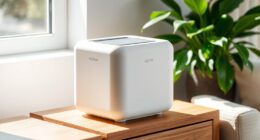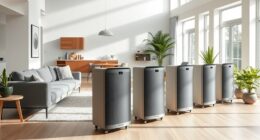To prevent mold, keep your home’s humidity around 50%. Use a hygrometer to monitor indoor moisture levels regularly. Employ dehumidifiers and ensure proper ventilation in bathrooms, kitchens, and basements by using exhaust fans and opening windows when possible. Fix leaks promptly and control indoor moisture sources like houseplants. Maintaining consistent temperatures and scheduling routine maintenance helps prevent mold growth. If you want to learn more about effective mold prevention strategies, keep exploring these tips.
Key Takeaways
- Maintain indoor humidity around 50% using a hygrometer and adjust with dehumidifiers or ventilation.
- Use exhaust fans in bathrooms and kitchens, and open windows to promote natural airflow.
- Regularly clean and inspect vents, filters, and dehumidifiers to ensure efficient moisture control.
- Repair leaks promptly, control indoor plant watering, and dry damp areas quickly to prevent excess moisture.
- Monitor temperatures with a smart thermostat and apply mold-resistant paint during renovations to reduce mold risk.
Understanding the Importance of Humidity Control
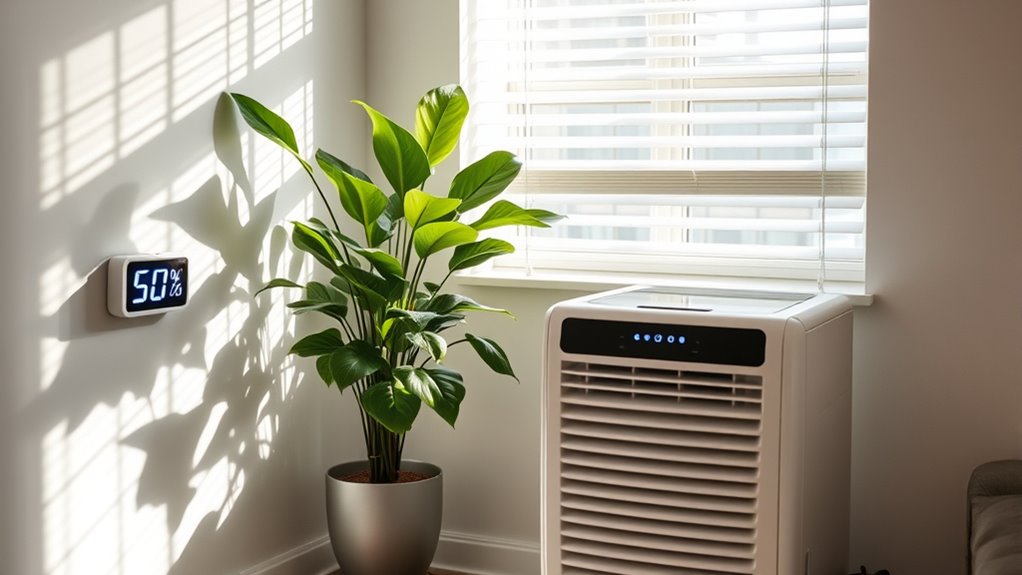
Controlling humidity levels is essential in preventing mold growth, as excess moisture creates the perfect environment for mold spores to thrive. Using humidity sensors helps you monitor indoor air conditions accurately, ensuring humidity stays within the ideal range. If humidity rises too high, mold can quickly develop on walls, ceilings, and around indoor plants. Indoor plants are beneficial, but they can also increase humidity if overwatered or placed in poorly ventilated areas. By keeping humidity levels balanced, you reduce the risk of mold taking hold. Proper monitoring with humidity sensors allows you to make quick adjustments, whether through ventilation, dehumidifiers, or reducing indoor plant watering. Maintaining optimal humidity levels is also important for vetted Halloween product reviews, as many costumes and decorations can be affected by moisture. Staying vigilant about humidity helps protect your home’s health and prevents costly mold remediation.
How to Measure Indoor Humidity Levels
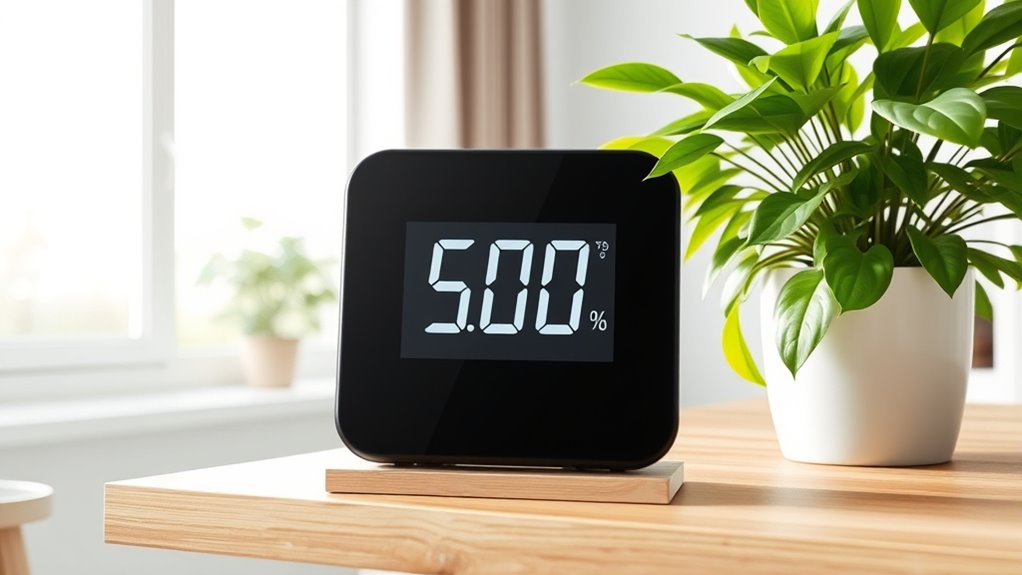
Wondering how to accurately measure indoor humidity levels? The best way is to use a reliable hygrometer, which reads humidity sensors to give you precise measurements. To guarantee accuracy, regularly calibrate your hygrometer—most models come with calibration instructions, or you can compare it against a known standard. Place your hygrometer in the room you want to monitor, ideally at eye level and away from direct sunlight or heat sources. Keep it steady and wait a few minutes for the reading to stabilize. Regularly checking your hygrometer helps you track humidity levels over time, ensuring your home stays around that ideal 50% mark. Proper measurement is key to preventing mold and maintaining a healthy indoor environment. Incorporating automation in business can also help monitor and adjust humidity levels more efficiently with smart devices.
Using Dehumidifiers Effectively

To get the most out of your dehumidifier, you need to place it in a location where it can evenly reduce humidity without obstruction. Regular maintenance, like cleaning the filters and emptying the water tank, keeps it working efficiently. When used correctly, your dehumidifier becomes a powerful tool in preventing mold growth. Additionally, positioning it near high humidity areas can optimize its effectiveness and ensure consistent moisture control.
Proper Dehumidifier Placement
Proper dehumidifier placement is essential for maximizing its effectiveness in preventing mold. To achieve this, focus on choosing the most suitable location where the device can efficiently draw in moist air. Place your dehumidifier in central areas of the room, away from walls and furniture that could block airflow. Avoid corners or tight spaces, as these can hinder air circulation and reduce dehumidification efficiency. Keep the unit elevated if possible, on a level surface to ensure proper drainage and operation. Remember, the right placement helps the dehumidifier target areas with high humidity and distributes dry air evenly throughout the space. By positioning it correctly, you’ll better control humidity levels and create an environment less prone to mold growth.
Regular Maintenance Practices
Regular maintenance is key to ensuring your dehumidifier works effectively in preventing mold. Start by regularly cleaning or replacing the air filter to maintain ideal airflow and efficiency. A clogged filter can make the unit work harder, reducing its ability to control humidity. Check the water collection tank and empty it frequently to prevent mold growth inside the device. Additionally, inspect the dehumidifier’s coils for dust buildup and clean them as needed. To complement this, consider applying mold-resistant paint on walls and ceilings, especially in moisture-prone areas. This extra barrier helps prevent mold spores from settling and growing. Regularly monitoring the air quality and humidity levels can further optimize performance. Consistent upkeep of your dehumidifier, combined with these protective measures, keeps humidity levels stable and minimizes mold risks effectively.
Ventilation Strategies to Reduce Moisture

To keep moisture levels in check, you should use exhaust fans in areas like the kitchen and bathroom regularly. Opening windows whenever possible helps circulate fresh air and reduces humidity. Additionally, installing air vents in key spaces guarantees proper airflow and prevents moisture buildup. Understanding the life-cycle assessment of your home’s ventilation system can further optimize moisture control.
Use Exhaust Fans
Using exhaust fans is one of the most effective ways to reduce moisture and prevent mold growth. They help with moisture removal by venting humid air directly outside, especially in high-moisture areas like the kitchen and bathroom. Turn on exhaust fans whenever you’re cooking, showering, or doing laundry to keep humidity levels in check. Make sure your fans are functioning properly and venting correctly outside, not into attics or crawl spaces. Installing high-quality exhaust fans can greatly improve indoor air quality and prevent mold spores from settling. Regular use of these fans ensures excess moisture doesn’t linger, reducing the risk of mold development and protecting your home’s structural integrity. Proper ventilation through exhaust fans is a simple yet powerful step in maintaining ideal humidity levels. Effective ventilation systems are essential for controlling indoor moisture and preventing mold from forming.
Open Windows Regularly
Opening windows regularly is one of the simplest and most effective ways to reduce indoor moisture levels. By allowing fresh air in, you promote window ventilation that helps dry out humid spaces. This practice encourages cross airflow, which moves moist air out and replaces it with drier outdoor air. To maximize airflow, open windows on opposite sides of your home or room, creating a natural draft that quickly reduces humidity. This simple step not only lowers moisture levels but also improves indoor air quality. Regularly ventilating your home prevents excess moisture buildup, which can lead to mold growth. Incorporating vertical storage solutions can also free up space and reduce clutter that traps moisture, further supporting mold prevention. Make it a habit during dry or less humid days, especially after activities that generate moisture like cooking or showering. Consistent window ventilation is a cost-effective way to keep your home less hospitable to mold.
Install Air Vents
Installing air vents is an effective way to improve indoor airflow and control moisture levels. Proper air vent design ensures ideal airflow, helping to reduce humidity that fosters mold growth. When selecting vents, consider size, placement, and type to maximize efficiency. Use vent installation techniques that create a secure fit and prevent leaks, which can trap moisture. Position vents in areas prone to dampness, such as bathrooms, kitchens, and basements, to facilitate consistent air exchange. Properly installed air vents promote ventilation, drying out excess moisture before it settles and causes mold issues. Regular maintenance, including cleaning and inspecting vents, keeps airflow unobstructed. Incorporating ventilation strategies can further enhance moisture control and prevent mold development. By focusing on good air vent design and precise installation, you markedly improve your home’s moisture management.
Managing Common Moisture Sources in Your Home
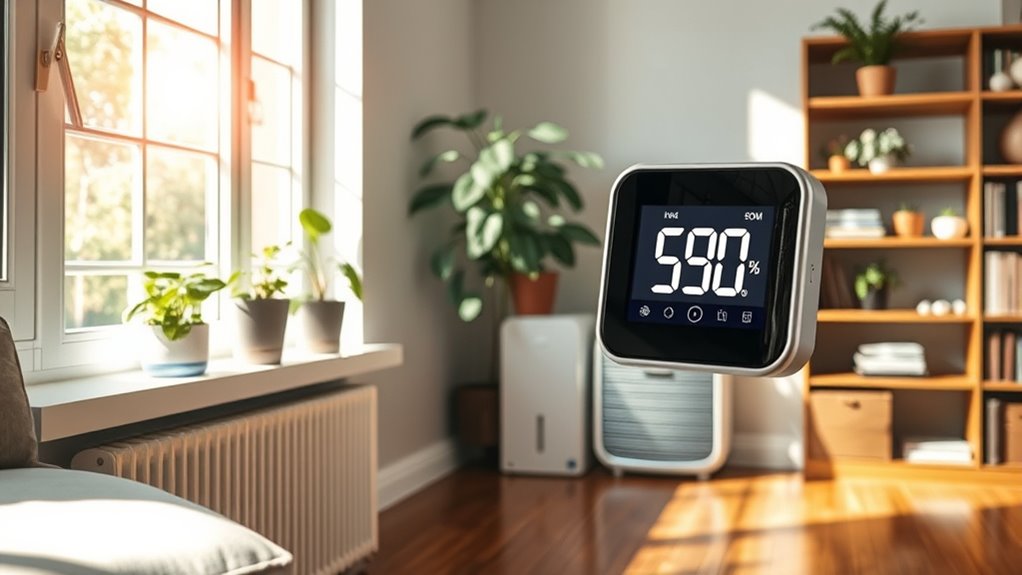
Since moisture is a primary factor in mold growth, managing the common sources of water in your home is essential. First, watch for basement condensation, which can collect on cool surfaces and create damp environments. Second, indoor plant moisture adds humidity; overwatering plants releases excess moisture into the air. Third, leaks from pipes or appliances can introduce persistent water issues if not addressed promptly. To prevent mold, dry out damp areas quickly, use dehumidifiers if necessary, and ensure proper drainage around your home. Regularly inspect areas prone to moisture, like basements and around houseplants, to catch problems early. Monitoring humidity levels and controlling excess moisture helps maintain ideal humidity levels and minimizes mold risk.
Tips for Proper Bathroom and Kitchen Ventilation

Effective ventilation in your bathroom and kitchen is key to preventing mold growth. Proper airflow reduces excess moisture, improves air quality, and minimizes mold risks. Use exhaust fans during and after showers or cooking to vent humid air outside. Keep windows open when possible to increase natural ventilation. Regularly inspect and clean ventilation systems to ensure they’re working efficiently. Consider mold testing if you notice persistent odors or visible mold. Properly ventilated spaces help maintain ideal humidity levels and prevent mold spores from settling. Additionally, maintaining proper humidity levels can significantly reduce mold development.
Climate Control and Heating Adjustments
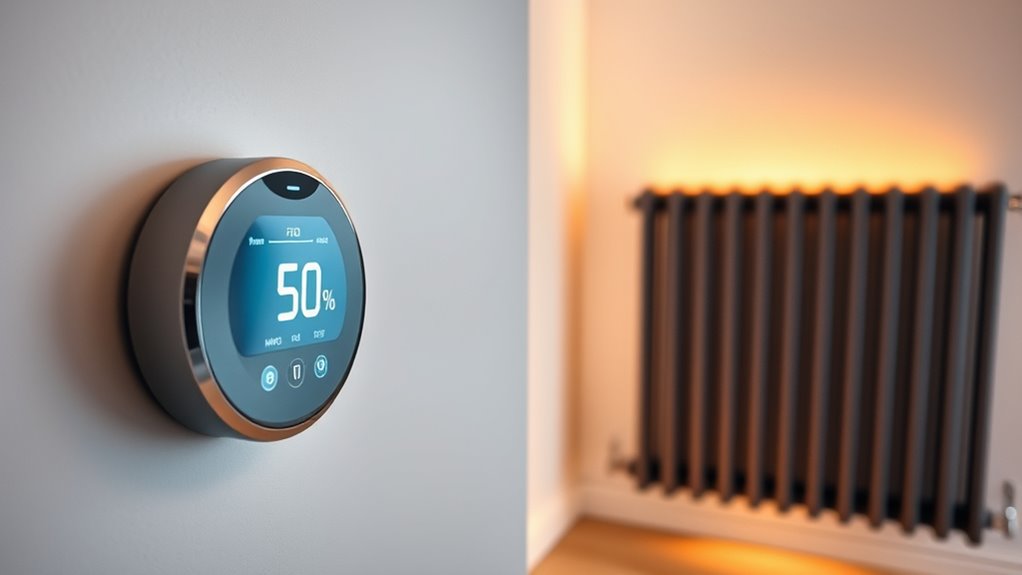
Maintaining proper climate control and adjusting your heating settings are essential steps in preventing mold growth. A smart thermostat allows you to maintain consistent temperatures, avoiding sudden fluctuations that can encourage mold. Radiant heating provides even warmth, reducing cold spots where moisture might condense. To optimize your system:
- Set your smart thermostat to keep indoor humidity around 50%, preventing excess moisture.
- Use radiant heating to evenly dry out damp areas and maintain a stable temperature.
- Schedule your heating to run consistently, avoiding temperature swings that promote mold growth.
- Regularly monitor and adjust your climate control systems to ensure optimal humidity and temperature levels.
Regular Maintenance and Monitoring for Mold Prevention
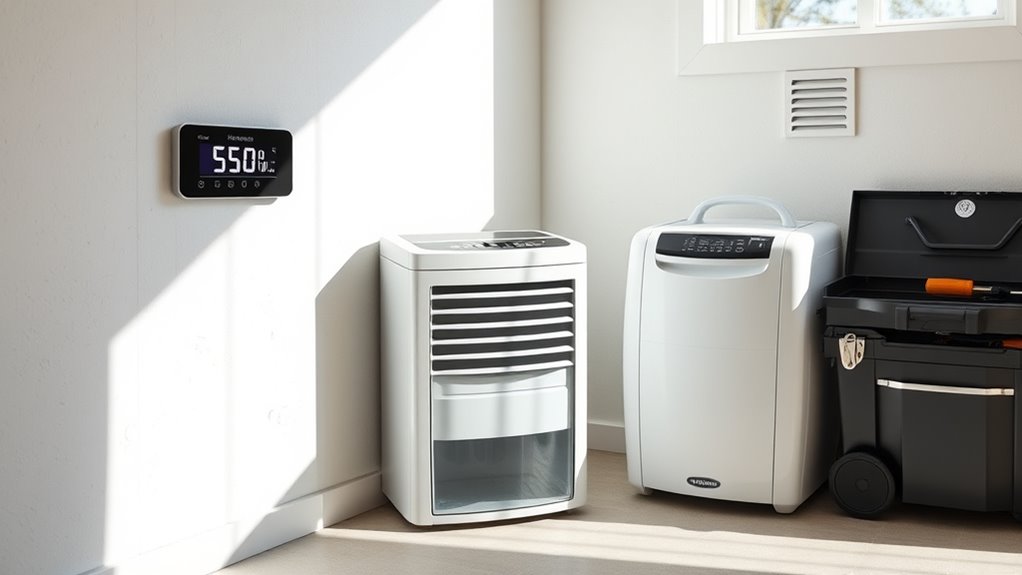
Regular maintenance and monitoring are key to catching mold problems early and preventing them from spreading. You should regularly check for leaks, damp spots, and poor airflow, which can foster mold growth. Air filter maintenance is vital—replace filters regularly to keep indoor air clean and reduce mold spores. Consider using mold-resistant paints in high-moisture areas to add an extra layer of protection. Keep an eye on humidity levels with a hygrometer, ensuring they stay around 50%. Here’s a quick guide:
| Task | Frequency | Area Focus |
|---|---|---|
| Check for leaks | Monthly | Bathrooms, kitchens |
| Replace air filters | Every 3 months | HVAC system |
| Inspect surfaces | Weekly | Walls, ceilings |
| Use mold-resistant paints | During renovation | Bathrooms, basements |
| Monitor humidity | Daily | Whole home |
Staying vigilant helps keep mold at bay, especially since proper ventilation plays a critical role in maintaining healthy indoor humidity levels.
Frequently Asked Questions
Can Plants Affect Indoor Humidity Levels?
Plants can definitely affect indoor humidity levels through a process called plant transpiration, where they release moisture into the air. If you have many indoor plants, they can increase humidity, making your environment feel more humid. This is one of the indoor plant benefits, especially in dry settings. To maintain ideal humidity, monitor your plants and adjust watering accordingly, helping you keep your home comfortable and mold-free.
What Are Natural Ways to Maintain 50% Humidity?
You’re in the driver’s seat when it comes to maintaining 50% humidity naturally. Think of using DIY dehumidifiers like charcoal or rock salt, which absorb excess moisture. Humidity sensors help you keep an eye on levels, so you don’t get caught off guard. Ventilating rooms regularly and placing houseplants that release moisture can also help balance humidity. With these tips, you’re steering your home toward a healthier, mold-free environment.
How Do Seasons Influence Indoor Moisture Control?
Seasons greatly influence your indoor moisture control through seasonal humidity and climate adaptation. In winter, indoor air tends to be drier, so you might need a humidifier to maintain ideal humidity levels. During humid summers, use dehumidifiers and ventilation to reduce excess moisture. Adjusting your home’s humidity based on seasonal changes helps prevent mold growth and keeps your living environment comfortable year-round.
Are There Specific Materials That Help Regulate Humidity?
Did you know that using the right materials can cut mold risk by up to 80%? You can choose from various humidifier types to maintain ideal humidity levels, like ultrasonic or evaporative models. Additionally, moisture-absorbing materials such as silica gel or charcoal can help regulate humidity naturally. These options work together to create a balanced environment, reducing excess moisture and keeping your home healthier and mold-free.
How Quickly Can Mold Develop After Humidity Changes?
Mold growth can start within 24 to 48 hours after humidity fluctuations create damp conditions. If you notice increased moisture from humidity changes, you should act quickly to reduce it, as mold spores thrive in moist environments. Humidity fluctuations can accelerate mold growth, so maintaining consistent humidity levels is key. Promptly addressing excess moisture prevents mold from developing and spreading, protecting your home’s health and integrity.
Conclusion
Keeping your home’s humidity around 50% is key to preventing mold, and it’s easier than you think. Even if you worry about the hassle, simple strategies like using a dehumidifier and improving ventilation make a big difference. Don’t let mold sneak in—by staying proactive and monitoring your indoor environment, you can enjoy a healthier, mold-free home without extra stress. Start today, and protect your space for years to come!






